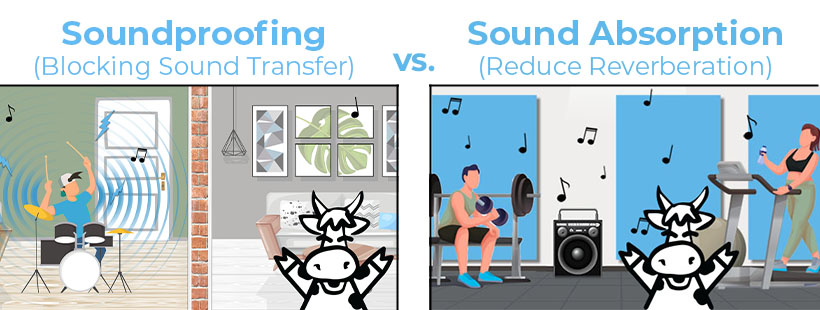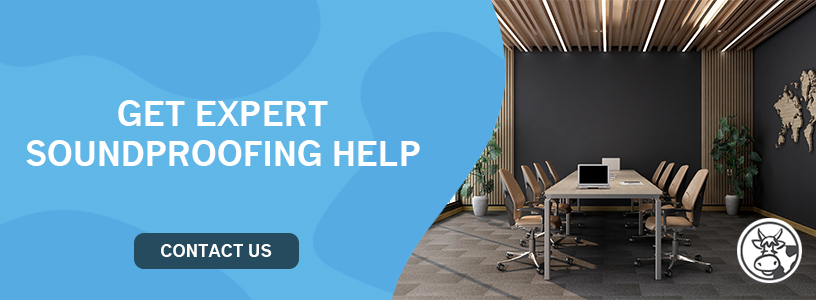
Soundproofing vs. Sound Absorption
Sound behaves a lot like water—it flows freely and always finds the path of least resistance. That is why managing sound in a space is not just about adding more insulation or thicker walls. It is about understanding how sound moves and choosing the right solution to control it.
Not all noise problems are created equal. Before you spend a dime on materials or labor, you need to know what problem you are really trying to solve. Are you trying to stop noise from coming in or out of a space, or do you want to make a room less echoey and more comfortable inside? The answer determines what products you need—and whether your project is truly DIY-friendly or requires professional installation.
This guide breaks down the difference between soundproofing and sound absorption—terms that are often confused, but have different acoustic functions. By the end, you will know which solution fits your space and your specific noise challenge—and how to take the next steps toward a quieter, more comfortable environment at home or at work.

What is the Difference Between Soundproofing and Sound Absorption?
Though they work toward the same goal—a better acoustic environment—soundproofing and sound absorption address different types of sound problems.
- Soundproofing stops sound from entering or leaving a space. It works by using dense materials and sealing gaps to block unwanted noise.
- Sound absorption absorbs sound waves reverberating within a space. This enhances sound quality inside a room. Absorptive materials soak up echoes and reverberations, creating a more comfortable and balanced listening environment.
Think of it this way:
- Soundproofing = stops sound transfer (think: blocking noise from neighbors)
- Sound absorption = improves clarity (think: taming reverberation in big rooms)
It is easy to mix up soundproofing and sound absorption—but using the wrong approach can leave you disappointed. Unsure which fits your space? A free acoustic analysis can help you clarify what your space really needs.

Soundproofing
Soundproofing is all about stopping sound in its tracks—preventing it from passing through walls, floors, ceilings, or doors.
How Soundproofing Works
Think of soundproofing as building a dam for noise. Sound travels through air and solid materials as vibrations, so the goal is to interrupt those paths. That is done by adding mass to slow down sound waves, separating materials so vibrations cannot pass easily, and sealing gaps that leak sound. This takes heavy, dense materials like Mass Loaded Vinyl (MLV), soundproof drywall, or specialized insulation. Every gap or crack needs to be sealed, because even the smallest hole can let sound slip through—weakening the entire barrier. The effectiveness of that barrier is measured by its Sound Transmission Class (STC) rating: the higher the number, the better it blocks airborne sound.
Key Soundproofing Strategies:
- Add mass: Use materials like Quiet Barrier® MLV to block sound.
- Decouple layers: Separate layers of drywall or use resilient channels to reduce vibration transfer.
- Seal gaps: Apply acoustical caulk and install door sweeps or weatherstripping to close openings. Use Quiet Batt® insulation inside wall cavities to further reduce sound transfer.
Applications of Soundproofing
Soundproofing is essential anywhere you want to keep noise in—or out. Imagine sharing a wall with a noisy neighbor, trying to sleep in a bedroom by a busy street, or running confidential meetings in a glass-walled office. Restaurants and gyms also depend on soundproofing to create comfortable environments. In any of these spaces, proper soundproofing helps maintain privacy, comfort, and focus—making the environment work the way it is meant to.
Sound Absorption
Sound absorption reduces echo and reverberation by capturing sound energy. It improves clarity and acoustics by controlling echoes and background noise, but does not prevent sound from passing through walls or ceilings. It makes rooms sound better—not quieter between rooms, but clearer within them.
How Sound Absorption Works
Imagine sound bouncing around a room like a ping-pong ball. Hard surfaces—glass, drywall, concrete—reflect them, creating echo and harshness. Soft, porous materials—like foam panels, acoustic cotton, or thick drapes—absorb sound waves as they pass through and dissipate that energy. That is how echoes fade and conversations become easier to understand.
Materials like acoustic foam, Echo Absorber™ Acoustic Cotton Panels, and Udderly Quiet® hanging baffles work by soaking up these reflections. Their performance is measured by the Noise Reduction Coefficient (NRC)—the higher the NRC, the more sound the material absorbs and the less echo remains in the room.
Applications of Sound Absorption
If you have ever noticed how a carpeted room is less noisy than one with bare walls and floors, you have experienced sound absorption at work. In open-concept offices, classrooms, restaurants, and studios, using the right materials can turn a loud, chaotic space into one that is comfortable for conversation, focus, and creativity.

Combining Soundproofing and Sound Absorption for Quieter Spaces
Most spaces achieve the best results when soundproofing and sound absorption work together. Soundproofing blocks airborne noise from entering or leaving a room, while sound absorption tackles echoes and improves clarity inside. On their own, each strategy solves part of the problem—but together, they create a space that is both private and pleasant to spend time in.
For example, soundproofing might keep street noise out of a home office, but adding sound-absorbing panels ensures that voices do not echo or sound harsh during meetings. The same is true for home theaters or recording studios, where you want to block distractions and enjoy clear, rich sound.
Quiet Barrier® Composite panels combine mass-loaded vinyl with absorptive foam for dual performance. The result is a space that is both quiet and pleasant to be in.
Case Study: Home Theater Soundproofing
A homeowner wanted to create a basement home theater where they could enjoy movies at full volume—without disturbing anyone upstairs or next door.
The challenge: Keeping loud sounds and vibrations contained within the theater, especially through shared walls and ceilings.
The solution: To tackle this, Quiet Batt® Soundproofing Insulation was installed in both the walls and the ceiling, providing a dense barrier against airborne sound. To further prevent sound and vibrations from traveling between floors, the isoTRAX® Soundproofing System was used in the ceiling. This approach focused entirely on soundproofing—using mass and isolation to block and contain noise.
The result: The theater delivered a powerful audio experience inside, while loud movie sounds stayed contained, causing minimal disturbance to the rest of the house.
Read the full home theater case study.
Note: To further enhance audio clarity and reduce echoes inside the theater, sound absorption products such as acoustic panels or foam could be added. Many homeowners choose to combine both approaches for the best possible experience.
Not Sure Which Solution You Need?
Scenario 1: “I can hear everything my neighbor says.”
Solution: Soundproofing
Scenario 2: “My conference room sounds harsh and echoey.”
Solution: Sound absorption
Scenario 3: “I want privacy and better sound quality in my podcast studio.”
Solution: Both
If you are still unsure, our team can help you analyze your space and recommend the right mix of materials.

FAQ
What Is STC?
STC, or Sound Transmission Class, measures how well a material or assembly blocks sound from passing through walls or barriers. Higher is better.
What Is NRC?
NRC, or Noise Reduction Coefficient, measures how much sound a material absorbs inside a room. A higher NRC indicates greater sound absorption, which helps reduce reflections and reverberation within a room.
If you are ready to address noise in your home or business, start by clarifying your goal: block unwanted noise, improve acoustics—or both. For help choosing the right solution, request an acoustic analysis or contact us.







